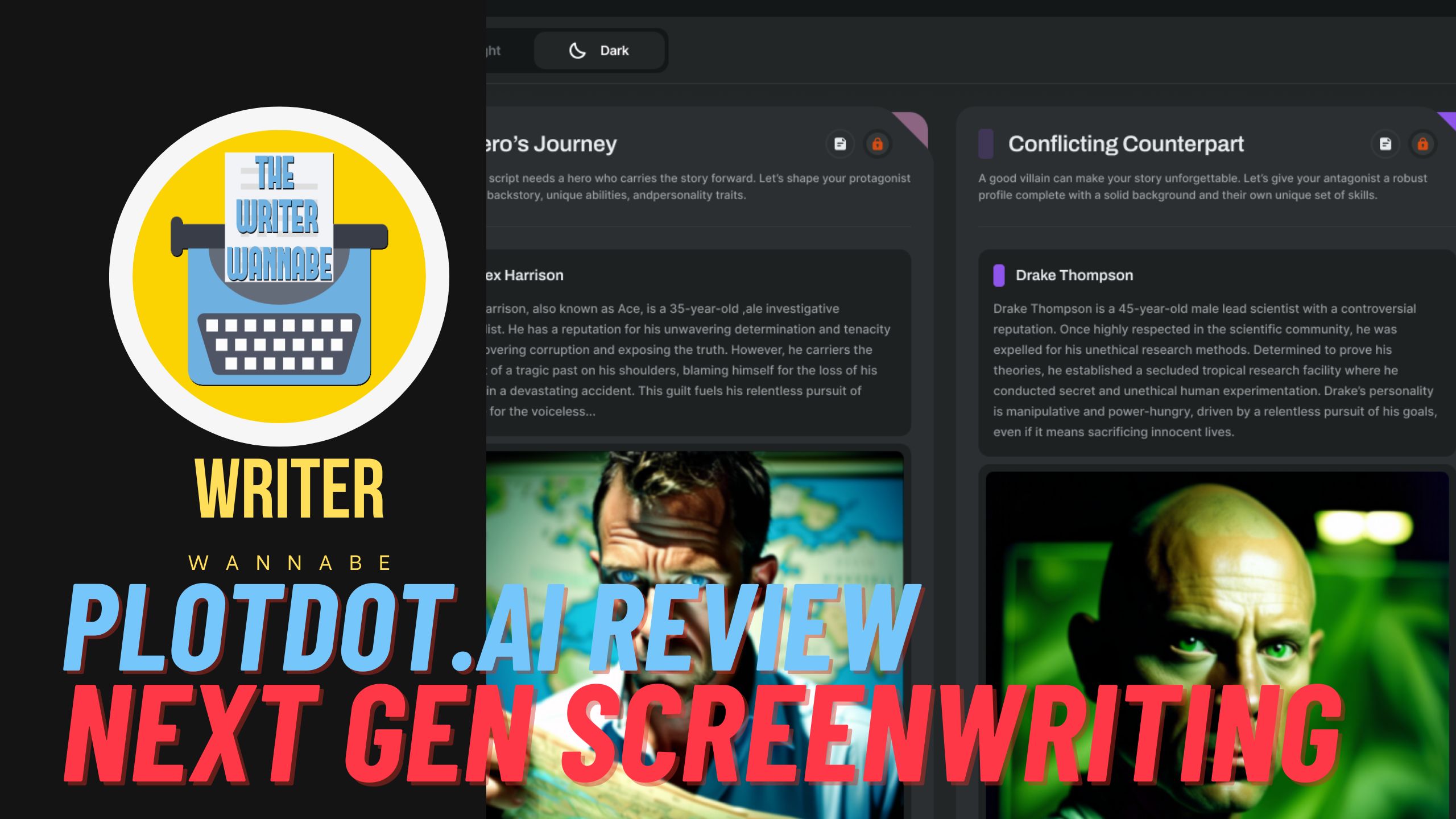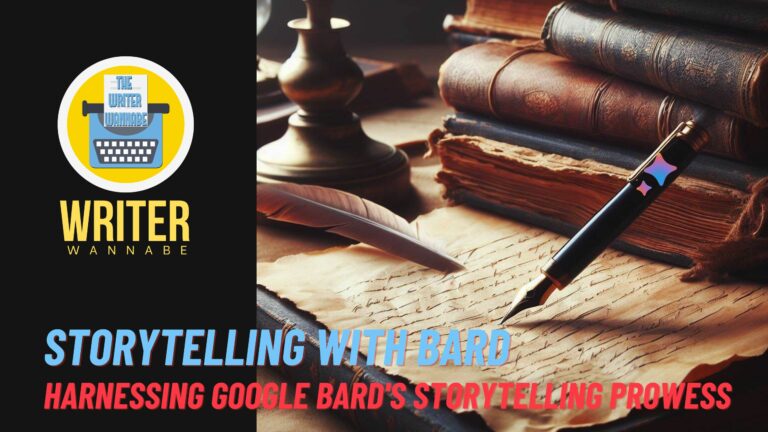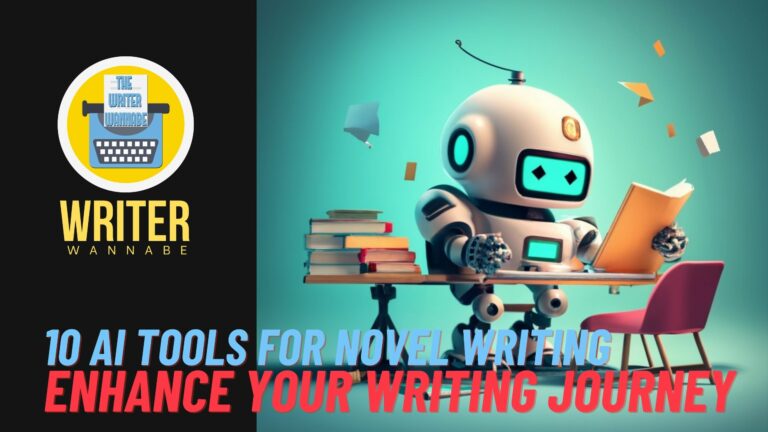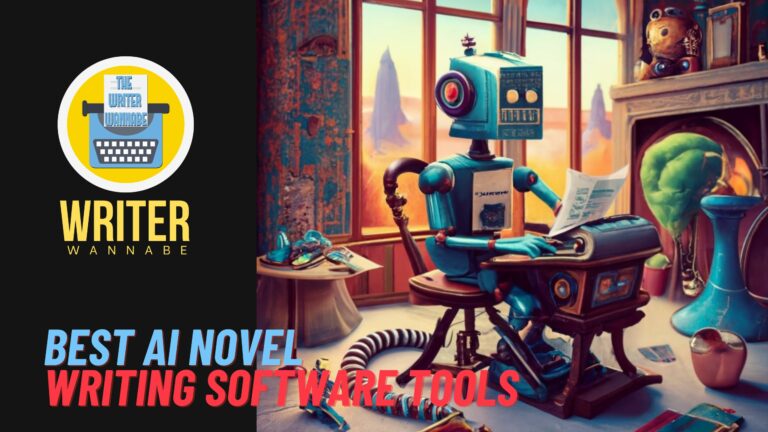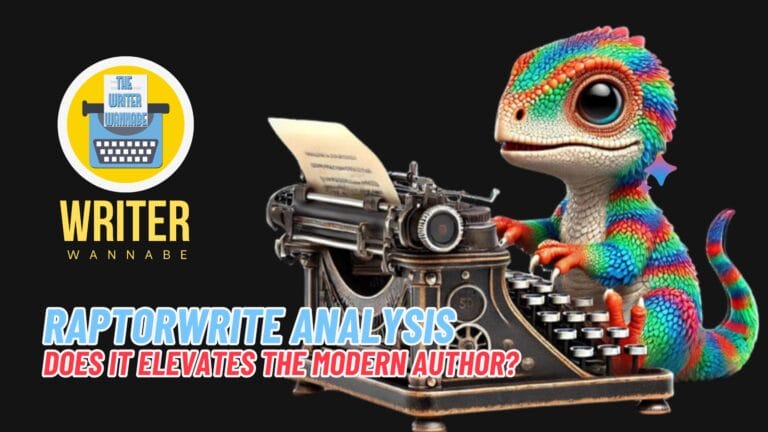PLOTDOT AI/ PLOT DOT AI review: An interesting AI tool to Generate Captivating Screenplays
An exhaustive PLOT DOT AI review & analysis, the tool that promises “studio-ready” scripts in minutes, and why professionals should think twice before using it.
As a creative technology analyst, I’ve seen dozens of tools that promise to be game-changers. Plotdot AI is one of the most ambitious I’ve ever encountered. It presents itself as the “smartest screenwriting companion ever built,” a bold claim in a market flooded with artificial intelligence solutions. Its proposition is simple and deeply appealing: transform your ideas into a complete screenplay in a fraction of the time it would traditionally take.
But does it deliver on its promise? The short answer is yes, but with a gigantic “but.” One so large it could jeopardize a professional screenwriter’s career. My analysis reveals a technologically impressive platform, almost magical in its ability to structure and generate stories. However, this magic vanishes when you read the fine print. Its own Terms of Service create a legal minefield that makes it, in its current state, an unviable tool for professional, commercial use.
Here’s a summary of what you need to know before we dive in.
Key Takeaways from the Analysis
- Creative Power vs. Legal Risk: Plotdot AI is exceptionally good for ideation, plot structuring, and character creation. Nevertheless, its Terms of Service shift all responsibility for originality and copyright onto the user, which invalidates the “chain of title” essential for selling a script.
- It’s Not for Everyone: The tool is ideal for aspiring screenwriters learning the craft, novelists exploring adaptations, or content creators working on non-commercial projects. Professionals, however, should only use it as a brainstorming tool, with the full understanding that all AI-generated text must be completely rewritten.
- Superior Specialized Technology: Unlike general AIs like ChatGPT, Plotdot offers a guided and specialized screenwriting workflow, from premise to final scene. Its structure-building engine is so powerful that some critics note it’s useful even without using the AI text generation features.
- The Engine Behind the Curtain: Plotdot isn’t just a simple app; it’s the public demonstration of its parent company’s technology, Thinkable AI. Thinkable AI specializes in enabling AI to execute complex tasks, giving Plotdot a more robust technological foundation than many of its competitors.
What Exactly is Plotdot AI and What Does It Promise?
Plotdot AI’s marketing is nothing if not direct. Its homepage greets you with an incredible promise: a first draft that traditionally “took months to write can now be generated in minutes”. This claim directly targets the biggest hurdle for any writer: time and the dreaded blank page syndrome. It positions itself as the ultimate creative companion, a tool that guides you from the spark of an idea to a final script, and even dares to say you can “write a screenplay, no prior experience needed“.
From my experience, tools that promise instant results often sacrifice quality. Plotdot, however, tries to avoid this trap with a structured approach. Instead of asking for a single prompt and spitting out a wall of generic text, it works more like a creative partner. It helps you overcome that initial block, giving you a springboard to transform vague concepts into detailed storylines. It doesn’t just sell itself as a text generator, but as a catalyst for your own creativity.
The idea is revolutionary, especially in an industry where ideas are gold, but execution is everything. The promise of dramatically accelerating the process without sacrificing narrative structure is, without a doubt, the platform’s biggest draw.

A Look Under the Hood: Analyzing the Tools
To understand if Plotdot’s promise is real, we have to break down its toolset. The platform is built on a philosophy of collaborative creation: you provide the core ideas, and the AI helps you shape and expand them.
The Structure and Outlining Engine: Its True Gem
This is where Plotdot really shines. Unlike general-purpose large language models (LLMs) that respond to a single prompt, the platform is focused on building a solid narrative architecture. It allows users to “generate detailed, streamlined outlines in a fraction of the time” and build the story with precision, act by act, turning point by turning point.
What I’ve observed in many AI tools is their inability to maintain long-term coherence. They get lost in the details and forget the main arc. Plotdot fights this with a process that forces you to think about the story’s foundation before writing a single line of dialogue. In my opinion, this is its strongest feature. It’s so effective as a plot organizer that a review from PCMag mentioned the interface would be useful on its own, without even activating the AI generation functions. This proves the underlying design is robust and built by and for screenwriters.
Character Creation and Arc Development
A great story needs memorable characters, and Plotdot dedicates a significant part of its arsenal to them. The platform helps you “forge deep conflicts and undeniable connections – fast“. It can instantly generate “rich, layered backstories that motivate authentic character behavior,” as well as create three-dimensional allies and antagonists.
User reviews often praise this capability, highlighting how the tool helps create well-rounded characters with detailed histories, adding valuable depth to the screenplay. But it’s not just about creating a static character sheet. The system is designed to build “emotional arcs built to serve the narrative,” ensuring that character development is intrinsically linked to the plot’s progression—a fundamental principle of good screenwriting that many novice writers struggle to master.
Dialogue and Scene Creation
Once the structure and characters are established, Plotdot moves on to the writing phase. It offers “intelligent scene suggestions to propel your narrative forward” and can “generate authentic dialogue, perfectly rooted in your characters’ unique voices and tone”.
This is a critical point. AI-generated dialogue often sounds robotic and generic. Plotdot tries to solve this by basing the dialogue generation on the character profiles you’ve previously created. The idea is that if you’ve defined your character well, the AI has an anchor to make their words sound consistent with their personality. This feature is what allows Plotdot to move from a simple planning tool to a full-fledged drafting assistant, capable of producing dynamic sequences and compelling scenes.
Does It Fit My Workflow? Integration with Industry Standards
One of the smartest decisions the Plotdot team made was not to reinvent the wheel, but to integrate with it. For any new creative tool to be adopted by professionals, it must be able to communicate with the software they already use.
Plotdot understands this perfectly and allows you to export your work to a variety of industry-standard formats: Final Draft (.fdx), Fountain (.fountain), PDF (.pdf), Microsoft Word (.docx), and Plain Text (.txt).
The inclusion of the .fdx format is, strategically, a masterstroke. Final Draft is the undisputed industry standard in film and television. Virtually all productions use it. By offering a direct export, Plotdot isn’t trying to compete with Final Draft, but rather to position itself as a complement. It presents itself as an “upstream” tool—one used in the earliest stages of the creative process.
The workflow they propose is clear: use Plotdot for the heavy lifting of ideation, outlining, and generating a first draft. Then, export that draft into Final Draft for the detailed polishing, collaboration, and final formatting that studios demand. This approach significantly lowers the barrier to entry for professionals, who can experiment with Plotdot’s AI capabilities without abandoning the software their career depends on. It’s a strategy that frames Plotdot not as a disruptor, but as a powerful new module in the modern screenwriter’s toolkit.
The Real-World Experience: What Users Who’ve Tried It Are Saying
Beyond the marketing, the true measure of a tool is the experience of its users. I’ve analyzed dozens of reviews, video walkthroughs, and forum discussions to get a complete picture of how Plotdot performs in the wild. And opinions are highly polarized.
The Enthusiasts’ Camp: Speed and Creative Partnership
Those who love Plotdot do so for one main reason: speed. The testimonial from F. Frank Medrano, associated with films like The Shawshank Redemption, featured on their website, calls the tool a “miracle” for its ability to produce a complete script in minutes. While testimonials on a product’s own site should always be taken with a grain of salt, this sentiment is echoed in third-party reviews that highlight its efficiency.
However, the most compelling evidence comes from detailed video series by creators like Ekello Harrid of Future Fiction Factory and Tim Stamps of ScreenwritingScribe, who document the entire process of using the tool. These tutorials showcase Plotdot’s potential to act as a “creative partner,” guiding users through a structured process that can be particularly helpful for those new to screenwriting or stuck in a rut. The specialized focus on screenplays is a key advantage over more generic tools.
The Skeptics’ View: Complexity and Output Quality
Despite the praise, a significant number of critiques point to several serious drawbacks. A recurring complaint is the “complexity for beginners“. Its rich feature set, which is a strength for some, can be overwhelming for new users, requiring a learning period to harness its full capabilities.
But the most significant concern is the quality of the generated text. There is a strong consensus that the output, while rapid, is at best a “vomit draft” (a very rough first pass). The text is often perceived as “generic and lacking the soul, nuance, and subtext” that a human writer provides. Even in video walkthroughs, the process isn’t always smooth. Reviewer Tim Stamps noted that the plot creation stage was “not so straightforward,” indicating that considerable user skill is needed to steer the AI effectively. Similarly, a hands-on test by PCMag found that the final script “deviates pretty drastically” from the initial human-guided outline, suggesting the AI can still lose the narrative thread.
The Current Context: The Crisis of Trust in the AI Era
It’s impossible to evaluate Plotdot without considering the current climate. We’re living through a growing crisis of trust fueled by the proliferation of AI-generated content. A recent study revealed a massive spike in suspected AI-generated reviews on platforms like Capterra. This phenomenon extends to the creative world; screenwriting forums are filled with users complaining about receiving generic, suspiciously fast feedback on script analysis platforms.
In this environment, text-based testimonials, like the one from “F. Frank Medrano” on Plotdot’s site, carry less and less weight. The ease with which such endorsements can be fabricated leads savvy consumers to doubt their validity.
This elevates the importance of verifiable, long-form reviews. The multi-episode video series that document the entire journey with the tool—showing both its successes and its failures in real time—become the most reliable form of feedback. They provide an auditable record of the platform’s performance that can’t be easily faked. Therefore, a credible analysis of Plotdot AI must give more weight to these transparent demonstrations than to isolated text reviews.
Plotdot in the Marketplace: Who Does It Compete Against?
Plotdot doesn’t exist in a vacuum. It enters a crowded and rapidly evolving market for writing software. Its success depends on its ability to carve out a unique niche among new AI startups, established giants, and powerful general-purpose language models.
The AI-Native Arena: Plotdot AI vs. Sudowrite
Within the category of AI-native creative writing tools, Plotdot’s best-known peer is Sudowrite. While both help writers, they serve different functions. Sudowrite is a broader tool for fiction authors, excelling at generating high-quality descriptive prose and expanding on existing text. Its strength is its “sentence-level” assistance, making it ideal for novelists.
Plotdot, in contrast, is hyper-specialized for the structural demands of screenwriting. Its primary strength is not in generating beautiful prose but in building a coherent narrative architecture. Where Sudowrite helps you find the right words, Plotdot helps you find the right structure. This makes them more like complementary tools than direct competitors.
There are also other direct competitors like RivetAI, which focuses more on pre-production and analysis, and FilmFlow, which offers scene generation and even a “character chat” function. Plotdot’s niche in this field is its emphasis on a guided, end-to-end generation process that prioritizes structural integrity above all else.
The Industry Giants: Can It Compete with Final Draft or Scrivener?
When compared to the established titans, Plotdot’s role becomes even clearer.
- Final Draft: As I’ve mentioned, Plotdot is not a direct competitor. Final Draft is the industry-mandated tool for formatting and production-level script management. Plotdot operates at the opposite end of the spectrum: ideation and first drafts. Its ability to export to the Final Draft format confirms this.
- Scrivener: The comparison with Scrivener is more interesting. Scrivener is a beloved non-AI software renowned for its organizational capabilities, allowing writers to manage vast amounts of research and notes. Like Plotdot, it’s excellent for outlining complex narratives. The fundamental difference is the engine driving the process. Scrivener provides a robust framework for you to fill in manually, offering total control. Plotdot offers a similar structural framework but integrates an AI engine to help generate the content. The choice between them comes down to a writer’s preference: Scrivener’s manual control versus Plotdot’s AI-assisted speed.
Competitive Feature Matrix
To clarify Plotdot’s specific role, this matrix compares its core attributes against its key competitors. For a writer, the decision often isn’t about choosing one tool, but about assembling a suite of specialized applications.
| Feature/Axis | Plotdot AI | Sudowrite | Scrivener | Final Draft |
|---|---|---|---|---|
| Primary Function | Guided Screenplay Generation & Outlining | AI-Assisted Creative Prose Generation | Project Management & Long-Form Composition | Industry-Standard Script Formatting & Production |
| AI Integration | Core to all functions | Core to all functions | None (integrates with third-party tools) | Minimal (basic spellcheck) |
| Target User | Aspiring/Professional Screenwriters | Novelists, Creative Writers | Authors, Academics, Screenwriters (for outlining) | Professional Screenwriters & Production Teams |
| Key Strength | Structured, step-by-step script development | High-quality prose/description generation | Unmatched organizational control (the “Binder”) | Industry-standard formatting, collaboration tools |
| Key Weakness | IP/Legal uncertainty; potentially generic output | Less structured for specific formats | Steep learning curve; no native AI | High cost; less focused on initial outlining |
| Pricing Model | Subscription (with credit system) | Subscription (credit-based) | One-time purchase | One-time purchase (with paid upgrades) |
The Most Important Issue: The Legal Framework and Intellectual Property
And now, we arrive at the most critical point of this entire analysis. For any creative professional, the legal terms governing a generative tool aren’t fine print; they are a core feature of the product. An analysis of Plotdot AI’s Terms of Service and Privacy Policy reveals legal risks that, in my opinion, fundamentally challenge its suitability for professional, commercial screenwriting.
Who Owns the Script? The “As-Is” Clause and IP Responsibility
Plotdot’s terms are brutally clear. All content the platform generates—scripts, outlines, characters, dialogue—is provided to the user “as-is”. The company does not claim copyright ownership, but—and this is crucial—it also offers no guarantee of it.
The legal responsibility is shifted entirely to the user. The terms explicitly state that users are “solely responsible for determining the suitability of any generated content for their purposes, including securing any intellectual property rights…necessary to exploit such content commercially”. Furthermore, the company “disclaims any and all liability for disputes regarding the authorship, originality, or protectability of AI-generated content” and provides no warranty that the output will be “unique, novel, or free from infringement of third-party rights”.
Let that sink in. The company itself is telling you that what it gives you could be identical or substantially similar to existing works or to content generated for other users.
A massive problem. 💣
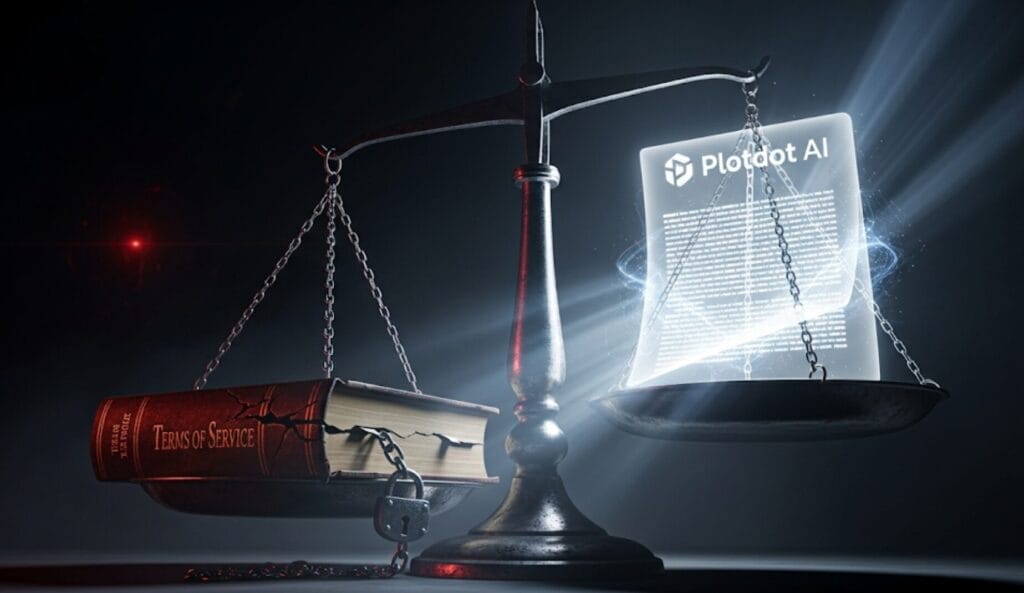
The “Chain of Title” Minefield: A Deal-Breaker for Professionals
These legal terms create an insurmountable obstacle for any screenwriter who intends to sell their work. In the entertainment industry, a “clean chain of title” is an absolute prerequisite for any transaction. A chain of title is the legal documentation that proves undisputed ownership of a creative property.
When a screenwriter sells a script, they must sign contracts that include warranties and representations, legally guaranteeing that they are the sole author of the work and that it is wholly original and does not infringe on any existing copyright.
Under Plotdot’s terms, it is legally impossible for a writer to provide that warranty with confidence. The company itself admits its output may not be original. A screenwriter who uses Plotdot-generated text cannot, in good faith, claim they are the sole author, because the tool’s operator provides no such assurance. This ambiguity is a major point of concern within the professional screenwriting community.
This directly contradicts Plotdot’s marketing of its output as being in a “studio-ready submission format“. Yes, the formatting might be correct, but its compromised legal status makes it radioactive to any producer, agent, or executive. The risk of future legal challenges over authorship would be too great.
Therefore, for professional use, any text generated by Plotdot must be considered legally insecure and would need to be completely rewritten by the human author to ensure an original expression of the idea, thereby re-establishing a clean chain of title. This fundamentally undermines the platform’s value proposition of speed and efficiency for the professional market.
What Happens to Your Ideas? Data Privacy and Model Training
Beyond ownership, there’s the use of your data. Plotdot’s terms state that the company collects personal information and, significantly, “any other materials you willingly submit to us such as articles, images, feedback, etc.“.
Most concerning for a creative is the clause granting the company a worldwide, royalty-free license to “use, reproduce, and analyze their inputs and generated outputs for the purpose of improving the Services” and to “use inputs and outputs for the purpose of improving and training its AI and other systems”. This means your unique ideas, prompts, and the resulting script excerpts are fed back into the system to train future versions of the AI. While this is standard practice, it raises serious concerns about the confidentiality of a writer’s original concepts.
Final Verdict: Who I Recommend Plotdot AI To (and Who I Don’t)
Synthesizing this entire analysis, the picture of Plotdot AI becomes clear. It’s a tool with immense potential, but with an Achilles’ heel that cannot be ignored.
Key Strengths and Weaknesses
- Strengths:
- High Specialization: Its exclusive focus on screenwriting is superior to general AIs.
- Powerful Structuring: Exceptional for overcoming writer’s block and building a solid narrative foundation.
- Workflow Integration: The .fdx export is a brilliant strategic decision.
- Weaknesses:
- Critical Legal Risks: The IP terms of service are a deal-breaker for professional use.
- Generic Output Quality: Reviews indicate the generated text requires intensive rewriting.
- Learning Curve: Can be complex for new users.
The Ideal Plotdot AI User Profile
Based on this analysis, I can clearly define who should be using Plotdot AI:
- ✅ Aspiring Screenwriters: Those learning the craft will benefit immensely from its guided structure.
- ✅ Novelists and Playwrights: Writers looking to adapt their works into a screenplay format can use it for a quick structural translation.
- ✅ Content Creators and Hobbyists: For projects where a formal chain of title isn’t critical (web series, video games, personal projects), it’s a powerful rapid-creation tool.
- ✅ Professionals (For Brainstorming Only): A professional screenwriter could use it in the very earliest stages to generate ideas, with the full understanding that all generated text must be discarded and rewritten from scratch.
And who should NOT use it:
- 🚫 A professional screenwriter on a deadline who needs to deliver a legally sound, commercially viable script to a studio, agent, or producer. The IP risks are, simply, too high.
The Future of Plotdot AI
Plotdot’s future is tied to its parent company, Thinkable AI. As a showcase for its technology, it will likely continue to evolve. It represents a significant step beyond generic chatbots.
However, for Plotdot to transition from a niche tool to an indispensable part of a professional screenwriter’s arsenal, it must confront its legal challenges head-on. This could involve developing AI models certified as not being trained on copyrighted material, offering an enterprise tier with legal indemnification, or integrating advanced plagiarism detection tools.
Without solving the fundamental puzzle of chain of title, Plotdot will remain a powerful but professionally limited “screenwriting companion.” If it can solve this crucial legal problem, its sophisticated approach to story architecture could, indeed, position it at the forefront of the next revolution in screenwriting. But for now, my recommendation is clear: use it for inspiration, not for your final product. Your career could depend on it.
We will try to cover more content from plotdot if of any interest for you, let us know in the comments.
For more interesting articles on AI tools for writer wannabes you can take a look our blog, we have also written a plotdot ai tutorial to get your first experience with the tool.
